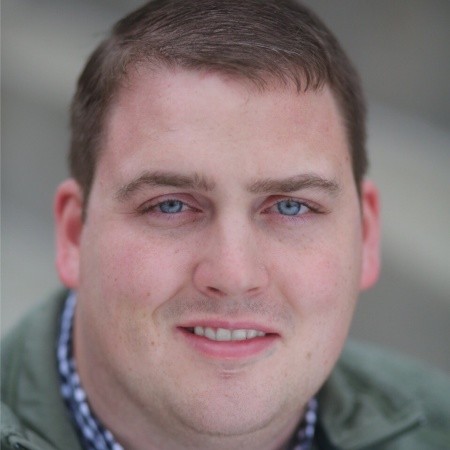
Ian Burkhart is C5 tetraplegic due to a diving accident in 2010. He took part in a clinical trial involving a brain-computer interface to manage muscle stimulation. This helped restore movement in his fingers and wrist. He will share his experience during the webinar. He is a member of the BCI Pioneers Coalition, a digital forum led by the world’s first implantable BCI research participants.
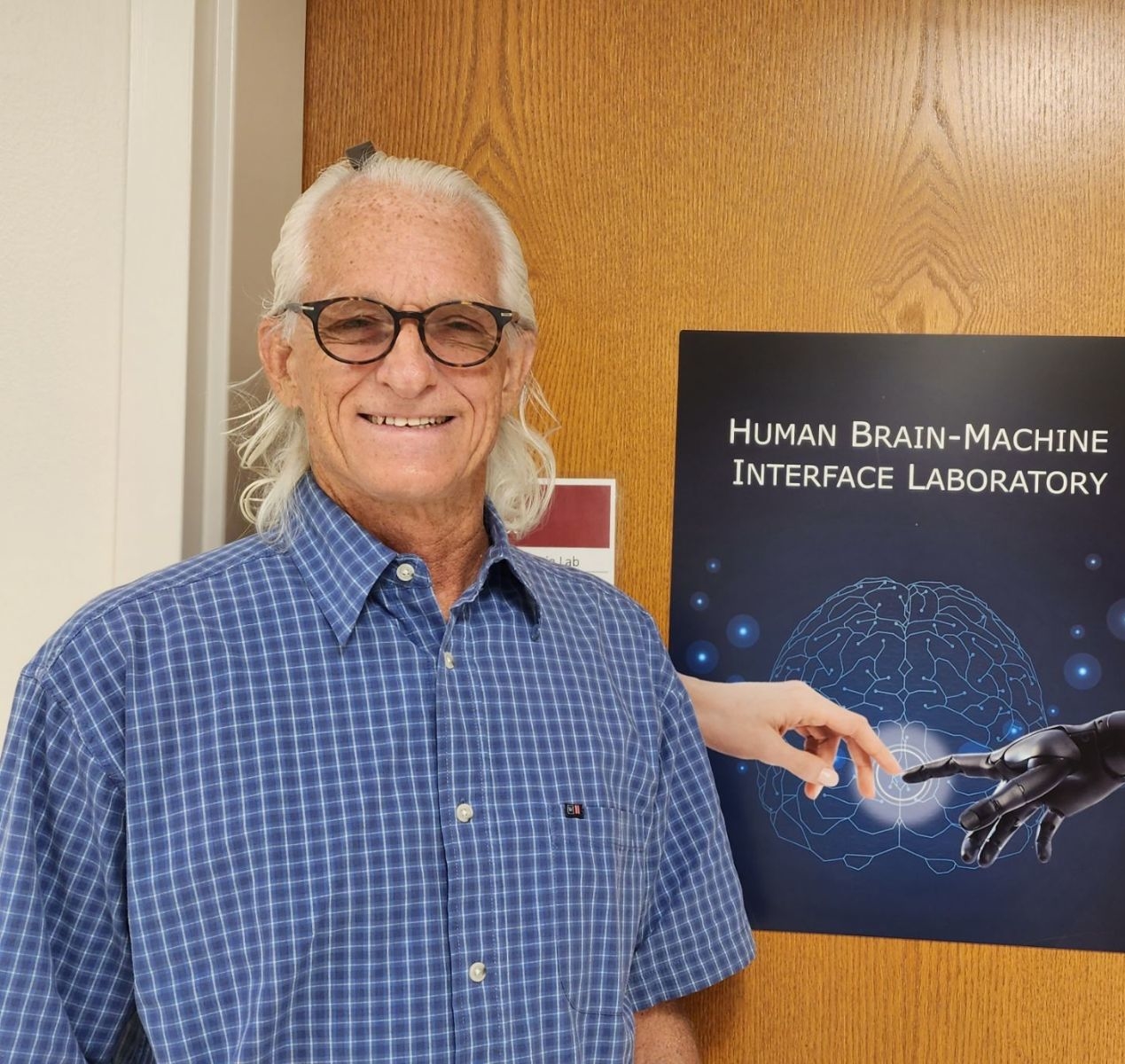 Scott Imbrie is an incomplete quad with fine motor skill limitation (C3-C5) from a car accident in 1985. In 2020, he joined the BCI study at UChicago wanting to help people with spinal cord injuries. Scott controls a robotic hand and arm aided by sensory feedback, also providing needed data for science.
Scott Imbrie is an incomplete quad with fine motor skill limitation (C3-C5) from a car accident in 1985. In 2020, he joined the BCI study at UChicago wanting to help people with spinal cord injuries. Scott controls a robotic hand and arm aided by sensory feedback, also providing needed data for science.
 Mijail Serruya, MD, PhD, directs the Raphael Center for Neurorestoration at the Farber Institute for Neuroscience at Thomas Jefferson University in Philadelphia. He co-founded Cyberkinetics and helped design the first BrainGate trial. Following training in neurology at the University of Pennsylvania, Dr. Serruya joined the faculty at Jefferson. In 2020 and 2021, he led the Cortimo trial in which four Blackrock arrays were implanted in the cerebral cortex of a person with chronic subcortical stroke; neural signals were decoded in real-time to trigger a powered orthosis to restore hand movement on the paretic hand.
Mijail Serruya, MD, PhD, directs the Raphael Center for Neurorestoration at the Farber Institute for Neuroscience at Thomas Jefferson University in Philadelphia. He co-founded Cyberkinetics and helped design the first BrainGate trial. Following training in neurology at the University of Pennsylvania, Dr. Serruya joined the faculty at Jefferson. In 2020 and 2021, he led the Cortimo trial in which four Blackrock arrays were implanted in the cerebral cortex of a person with chronic subcortical stroke; neural signals were decoded in real-time to trigger a powered orthosis to restore hand movement on the paretic hand.
Abstract: Dr. Serruya will describe the trial design, main findings and lessons learned from the Cortimo trial. He will discuss the NuroSleeve upper extremity assistive system and the RISES spinal cord stimulation program. He will briefly touch on currently available assistive devices and the applications of implanted vagus nerve, deep brain cerebellar, cortical and spinal cord stimulation to movement recovery after stroke.
WEBINAR 8 on “Neuroethics in the age of innovation” – October 27th, 4pm CEST (on Zoom)
Presentation on neuroethics in the world of BCI with Ranganatha Sitaram (St Jude Children’s Research Hospital), Nicola Di Stefano (National Research Council of Italy, chair of the B-CRATOS ethics board) and Luca Valera (University of Valladolid)
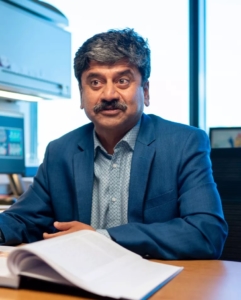 Ranganatha Sitaram is a full professor and member of faculty in the Diagnostic Imaging Department and Director of Multimodal Functional Brain Imaging and Neurorehabilitation at St Jude Children’s Research Hospital. He is a researcher in the interdisciplinary areas of cognitive neuroscience, biomedical engineering, and computational intelligence.
Ranganatha Sitaram is a full professor and member of faculty in the Diagnostic Imaging Department and Director of Multimodal Functional Brain Imaging and Neurorehabilitation at St Jude Children’s Research Hospital. He is a researcher in the interdisciplinary areas of cognitive neuroscience, biomedical engineering, and computational intelligence.
Ranganatha Sitaram has bachelor’s and master’s degrees in engineering from India, and a PhD in neuroscience from the University of Tubingen (Germany). He has wide international experience and worked in several faculty positions, including in the University of Tubingen, the University of Florida in Gainesville (USA), the Pontificia Universidad in Santiago (Chile), and visiting professorships at the Wyss Center for Neuro & Bio Engineering in Geneva (Switzerland) and the Sri Chitra Tirunal Institute of Biomedical Sciences (India).
Abstract: My speech will highlight some of the most prominent developments in BCI, BMI, and neurofeedback, providing a future outlook on the topic. Furthermore, it will consider some of the questions concerning the relationship between neuromodulation and human agency.
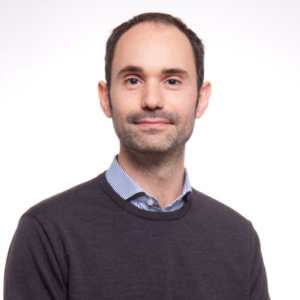 Nicola Di Stefano is a researcher at the National Research Council of Italy. His research interests lie at the intersection between philosophy, psychology, and cognitive science, with a focus on the philosophy and psychology of perception, aesthetics, ethics and technology. He has published over 30 articles in scientific journals, including Science Engineering Ethics, International Journal of Social Robotics, Attention, Perception & Psychophysics, Review of Philosophy and Psychology. He is currently involved in several EU-funded research projects (CONBOTS, NIMA, B-CRATOS).
Nicola Di Stefano is a researcher at the National Research Council of Italy. His research interests lie at the intersection between philosophy, psychology, and cognitive science, with a focus on the philosophy and psychology of perception, aesthetics, ethics and technology. He has published over 30 articles in scientific journals, including Science Engineering Ethics, International Journal of Social Robotics, Attention, Perception & Psychophysics, Review of Philosophy and Psychology. He is currently involved in several EU-funded research projects (CONBOTS, NIMA, B-CRATOS).
Abstract: Recent approaches to the ethics of technological artefacts proposed that, in order to determine what value an artefact embodies, it must be possible to determine what actions it affords. We can refer to this idea with the term “ethical affordance”. In my talk I will try to argue that, while the notion of ethical affordance can be straightforwardly applied to approach the ethics of traditional tools that have a material structure, it seems less helpful when it comes to facing issues arising from fully implanted neurotechnologies, such as BCIs, which lack material structure. I conclude suggesting that the latter technologies call for a shift towards a novel and more adequate ethical framework.
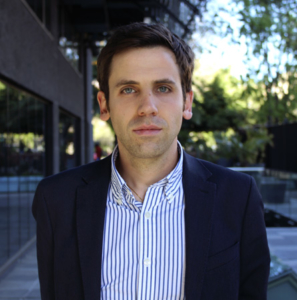 Luca Valera is a professor at the University of Valladolid (Spain), Department of Philosophy. He studied Philosophy at the Università Cattolica del Sacro Cuore di Milano. He holds a PhD in Bioethics and Philosophy from the Università Campus Bio-Medico di Roma. His doctoral thesis was on the subject of human ecology, in the field of environmental ethics. He hold several professor positions, of Medical Anthropology at the Università Cattolica del Sacro Cuore di Roma and of Human Ecology and Sustainability at the Università Campus Bio-Medico di Roma, taught philosophy and bioethics at the Pontificia Universidad Católica de Chile.
Luca Valera is a professor at the University of Valladolid (Spain), Department of Philosophy. He studied Philosophy at the Università Cattolica del Sacro Cuore di Milano. He holds a PhD in Bioethics and Philosophy from the Università Campus Bio-Medico di Roma. His doctoral thesis was on the subject of human ecology, in the field of environmental ethics. He hold several professor positions, of Medical Anthropology at the Università Cattolica del Sacro Cuore di Roma and of Human Ecology and Sustainability at the Università Campus Bio-Medico di Roma, taught philosophy and bioethics at the Pontificia Universidad Católica de Chile.
Abstract: Along with the rapid evolution of neurotechnologies, ethical and political concerns have grown based on the fear of the potential misuse of neurotechnology. This is the case of neurorights. In this speech, I will focus on some philosophical and ethical problems in neurolegislations, pointing out the necessity of urgent bioethical considerations on this emerging technologies.
B-CRATOS SUMMER SCHOOL – 27-29 September, Trondheim, Norway
Next Generation Wireless Brain Machine Interface Contact
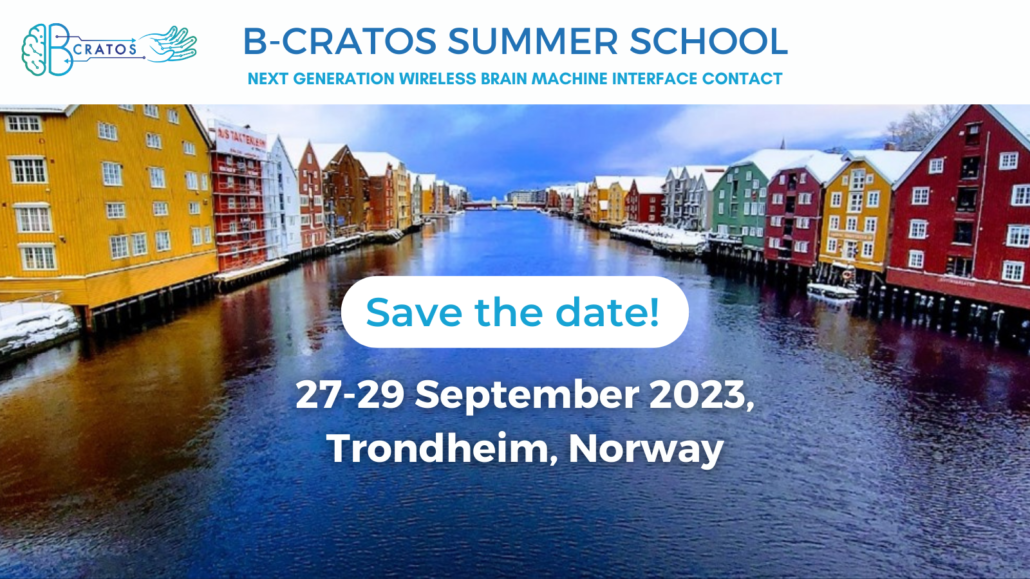
B-CRATOS organizes a Summer School, focusing on Brain Machine Interface but also covering other key technical aspects of the B-CRATOS ambitious project. It will help strengthen your knowledge through direct insights from the B-CRATOS team members and invited speakers.
Wireless technology for brain machine implants has emerged as a cutting-edge field of research, with potential to revolutionize the way we interact with technology and augment our cognitive capabilities. The integration of wireless technology with brain-machine interfaces enables bidirectional communication between the brain and external devices, providing a powerful tool for both diagnostic and therapeutic applications. The importance of this technology lies in its potential to improve the quality of life for individuals with neurological disorders, such as Parkinson’s disease, epilepsy, and paralysis. Wireless brain-machine interfaces can provide targeted stimulation to specific brain regions, restoring lost function and improving cognitive performance. Additionally, wireless implants can provide continuous monitoring of brain activity, allowing for early detection and intervention in cases of neurological disorders.
More information on the dedicated page.
WEBINAR 7 on “The artificial substitution of missing hands“
The replacement of a missing hand by a prosthesis is one of the most fascinating challenges in rehabilitation engineering. For decades, science and engineering have tried to match the sensory and motor features of the human body, designing limbs aiming at replicating the shape and functionality of the natural counterparts. Building such incredible devices and making them wearable and intuitively controllable by people is the goal of prosthetics research. This talk aims at providing an overview of past and present artificial prosthetic hands developed and at discussing the main design issues.
Webinar summary and speakers bio
Presentation by Dr. Marco Controzzi (Assistant Professor at Scuola Superiore Sant’Anna) and Dr. Francesco Clemente (Managing Director at Prensilia SRL, Affiliate Professional at Scuola Superiore Sant’Anna
WEBINAR 6 on “Artificial Sensors: towards human-like sense of touch by means of neuromorphic approach”
Conventional electronic (e-) skin, as a large-area electronic device for sensing tactile events, comprises a sensor array, which analog signal is readout by serially sampling individual sensors in the array.
The generated frame-based data are usually utilized by machine learning based on artificial neural network (ANN) for artificial sense of touch, e.g., object classification, by touching and grasping.
The conventional e-skin has poor energy efficiency that prevents it from up-scalability, and is ill-suited for taking advantage of dynamic tactile information required for rapid tactile feedback.
In this talk, design and development of new e-skins for energy-efficient, dynamic tactile feedback are to be presented.
By means of the neuromorphic approach based on neuroscientific theory, building blocks for artificial tactile sensory systems are designed.
By means of in mixed hardware and software implementation, event-driven neuromorphic tactile systems that efficiently code dynamic tactile information for rapid object classification, and exhibit an enhancement in the spatial resolution in response to touching and grasping events are demonstrated.
WEBINAR 6 – Speaker Biography and Summary
Presentation by Dr. Zhibin Zhang and Dr. James Goodman.
WEBINAR 5 on “Machine Learning – Current Challenges and Opportunities for Neuroprosthetics“
Brain-computer interfaces (BCIs) promise to be an alternative treatment for individuals with a disability, giving them a chance to regain their interaction capacity with the environment and with others. At the same time, Modern AI/ML techniques are changing paradigms in technology and in medicine.
In combination, BCIs and modern ML have the potential of revolutionizing the treatment of neurological conditions. Yet, when both technologies meet, there are still challenges to face. From decoding the mysteries of brain activity to the development of training tools, steps remain to be taken to harness the full power of AI and include the vibrant ML community in the creation of next-generation BCIs.
In this 5th webinar, we will talk about the challenges, and thus consequently, the opportunities in current intracortical BCI development. Departing from our own experience decoding brain activity, data science, and high-performance computing, as well as an example BCI study in human subjects, we will talk about what we believe ML can offer to advance BCIs. With this webinar, we also hope to provide some pointers on how some of you, as individuals with programming skills, can help bridge this gap.
WEBINAR 5 – Speaker Biography and Summary
Presentation by Paolo Viviani (PhD), Dr. Andres Agudelo-Toro and Dr. Brian Dekleva (PhD).


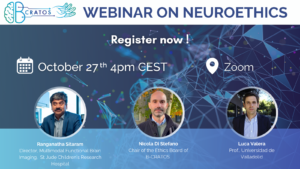
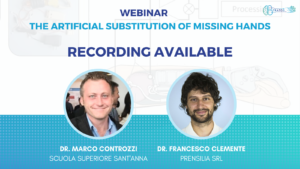
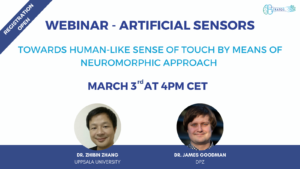
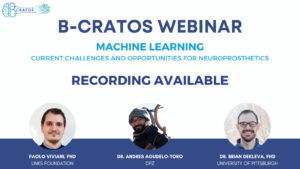
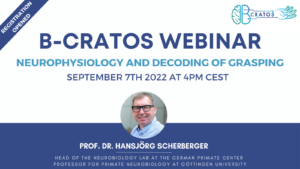
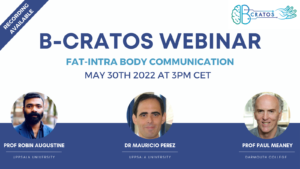
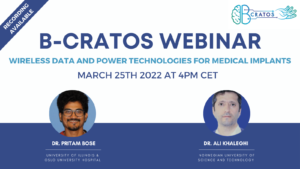
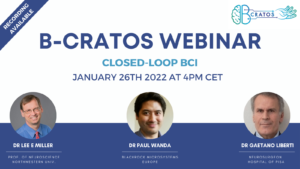

Recent Comments